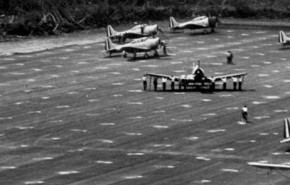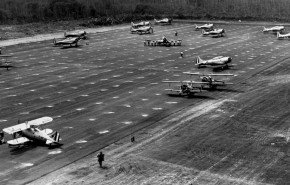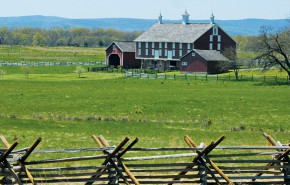GAI AVP Ben Resnick, MA, RPA discusses a range of historical archaeology methods that are assisting efforts to expand sections of the World War II-era Ewa Field military site for inclusion in the National Register of Historic Places.
Ewa Field is located just a few miles west of Pearl Harbor, Hawaii, and was similarly attacked on December 7, 1941. Ewa Field’s South Revetment Historic District is now on its way toward attaining historic significance due to its concentration of distinctive, well-preserved, half-dome revetments built to protect aircraft following the December 7 attack.
Ewa Field: a Key to U.S. Victory in the Pacific
In 1941, Marine Corps Air Station Ewa Field comprised an airfield, an assortment of aircraft, and a temporary Marine camp. On December 7, 1941, Ewa was targeted by Imperial Japanese Navy planes approximately two minutes prior to the bombardment of Pearl Harbor five miles to the east—destroying U.S. aircraft on the ground.
Expanded after the attack, Ewa Field became a major Marine aviation training facility between 1942 and 1943 as well as the location for Navy Carrier Aircraft Service Unit (CASU) flight crews and mechanics. CASUs were integral to the success of the island-hopping strategy in the Pacific.
Marine and Naval aviators trained at Ewa participated in most of the major engagements in the Pacific including Wake Island, Guadalcanal, Iwo Jima, Midway, and many others. It was at Midway in June, 1942 that Navy flight crews crippled or sunk four Japanese aircraft carriers in what would come to represent the turning point in the Pacific theater. Ewa Field was used early during the Korean War, but was closed in 1952 because its runways were unsuitable to accommodate jet aircraft. The facility remains under the control of the U.S. Navy.
Expanding the Boundaries of Protection
Based on GAI’s earlier work, a significant section of the site, defined as the ‘Ewa Plain Battlefield,’ earned National Register of Historic Places designation in 2016. In 2018, a detailed nomination was submitted to the United States Department of the Interior, National Park Service to qualify the ‘Ewa Field South Revetment Historic District’ for the designation as well.
A ‘revetment’ is a structure built to camouflage and protect aircraft during an attack. Ewa Field contains some 75 of these structures, 32 of which are contained within the Ewa Field South Revetment Historic District. Ewa Field’s concrete revetments are distinctive for their half-dome design—and while now more than 75 years of age, most are in extremely good repair, a testament to their thoughtful and durable construction and lack of post-WWII development. Many of the revetments are used currently as horse stables by the Barbers Point Riding Club, the site’s current resident, which commissioned the National Register of Historic Places nomination initiative.
![]()
Historical Archaeology Helps Reconstruct Distinguished Legacy
A multi-faceted effort benefiting significantly from GAI’s partnership with local historians and veterans has created a vivid picture of Ewa Field’s past.
Research into the Ewa Field South Revetment Historic District’s history gathered archival newspaper accounts, base histories, images, letters, and more. These resources helped document the development of Ewa Field’s distinctive revetments and establish the district’s significance within the historical context of WWII.
Light Detection and Ranging (LIDAR) images assisted the identification and mapping of revetments that were obscured by vegetation overgrowth, saving critical time in the field. LIDAR uses pulsed radar to make accurate 3-D representations of a target area; LIDAR technology was recently in the news for its role in revealing hidden ruins surrounding the Maya city of Tikal.
Geophysical studies including Ground Penetrating Radar (GPR) and magnetometer surveys helped reveal hidden tarmacs, taxiways, and the foundations of buildings appearing on WWII-era maps that are no longer standing or visible. Geographic Information System (GIS) data collection, analysis, and mapping worked to create detailed and comprehensive inventories of the site’s significant features.
Traces of Servicemen Etched Into Structure Walls
Site studies reveal that Ewa Field is worthy of preservation not only for its significant role during WWII, but also as a lasting tribute to the many servicemen stationed at the facility. Examination of many revetment walls has revealed art and writing that often reflects the names, dates of service, and home towns of servicemen who manned the facility during the war years—committed young people who have earned remembrance for their contribution to the U.S. war effort.
![]()
Saving a Significant Piece of History
Clearly, Pearl Harbor was not the whole story—and until fairly recently, Ewa Field was an unknown and lost battlefield. However, Ewa Field boasts a rich history that is worth telling as it opens a window into a significant, storied, and very human past. Historical archaeology techniques provide the tools to bring this past into view, and the contributions of local historians add color and context to our findings. The results, all told, define Ewa Field’s role in the Second World War, deepen a community’s sense of history, and honor the service and sacrifice of many brave Americans.
Contact GAI Assistant Vice President Ben Resnick, MA, MBA, RPA for more information about GAI’s archaeology, architectural history, historic preservation, and National Register of Historic Places nomination services.
GAI VP Ben Resnick Addresses Battle of Midway Commemoration Ceremony
![]() On June 2, 2018, GAI’s Ben Resnick, MA, RPA addressed the Battle of Midway 76th Commemoration Ceremony, held at Ewa Field, Hawaii. The event was co-presented by American Veterans (AMVETS) Hawaii and the Barbers Point Riding Club.
On June 2, 2018, GAI’s Ben Resnick, MA, RPA addressed the Battle of Midway 76th Commemoration Ceremony, held at Ewa Field, Hawaii. The event was co-presented by American Veterans (AMVETS) Hawaii and the Barbers Point Riding Club.
Working with local historians, GAI conducted an archaeological survey of the Ewa Field South Revetment Historic District in preparing the site’s nomination for inclusion in the National Register of Historic Places.
![]() Ben Resnick, MA, RPA specializes in historical archaeology and Geographic Information System archaeological predictive modeling. With more than 30 years’ experience, Ben is involved in developing opportunities and managing environmental permitting projects focusing on the energy, transportation, and government market sectors. Areas of specialization include management of open-end agreements focusing on staffing, schedules, quality and cost controls, technical report preparation, and State Historic Preservation Office and Native American consultation.
Ben Resnick, MA, RPA specializes in historical archaeology and Geographic Information System archaeological predictive modeling. With more than 30 years’ experience, Ben is involved in developing opportunities and managing environmental permitting projects focusing on the energy, transportation, and government market sectors. Areas of specialization include management of open-end agreements focusing on staffing, schedules, quality and cost controls, technical report preparation, and State Historic Preservation Office and Native American consultation.


